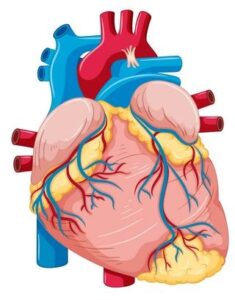
Exploring the Parts of the Human Heart & Their Functions
Introduction
Welcome to my blog, where I, Dr. Ashish Agrawal, am excited to take you on a journey through the intricate world of the human heart.I am an interventional cardiologist at The Heart Clinic in Mulund & Bhandup, Mumbai.
In this article, we’ll unravel the mysteries of the parts of the human heart and their fascinating functions.
So, let’s dive right in and explore the wonders that make your heart beat with life.
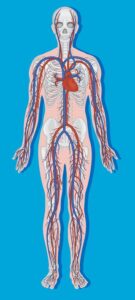
1. Position – Where the Magic Happens
Positioned within your chest, the human heart finds its abode between the lungs, slightly tilted towards the left side of your body.
This strategic location allows for efficient pumping and distribution of blood, catering to the body’s diverse needs.
Functions of the Human Heart – The Symphony of Life

2. Types of Circulation
The human heart orchestrates two types of circulation: pulmonary and systemic.
In pulmonary circulation, the heart pumps oxygen-depleted blood to the lungs for oxygenation.
In systemic circulation propels oxygen-rich blood throughout the body to nourish cells and organs.
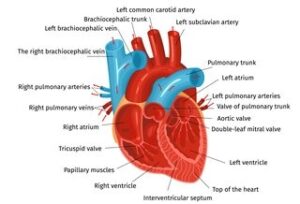
3. Structure of the Human Heart
Pericardium
Imagine your heart being embraced by a protective, double-layered sac called the pericardium.
This membrane safeguards your heart against external impacts and friction, allowing it to beat smoothly.
Structure of the Heart Wall
The heart wall consists of three layers: the outer epicardium, the muscular myocardium, and the inner endocardium.
Let’s study it in more detail for a better understanding.
Epicardium-
It is composed of a thin layer of membrane that serves to protect & lubricate the outer part of the heart.
Myocardium–
It is the middle muscular part of the heart. It is responsible for the pumping function of the heart.
It is also responsible for the thickness of the heart wall.
Endocardium-
It is the innermost layer of the Heart which covers the Heart chambers and heart valves.
It prevents blood from sticking to the inner wall of the heart. Thus it helps to prevent life-threatening blood clots.
These layers work harmoniously to ensure effective pumping action.

Chambers of the Heart
Your heart is divided into four chambers: two atria (upper chambers) and two ventricles (lower chambers).
The atria receive blood while the ventricles pump it out, maintaining a rhythm that powers your circulation.
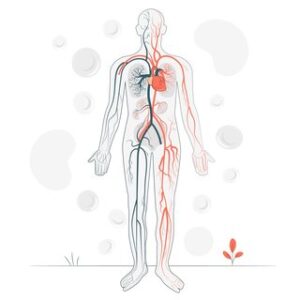
4. Blood Vessels
The human blood circulatory system is a closed circulatory system.
Now you must have a question in your mind; What does it mean?
It means Human blood flows throughout the body through different types of blood vessels. These blood vessels help to carry blood towards as well as from different body parts to perform their functions.
These blood vessels spread all over the body. They have a strong network in the body. Blood vessels are of different sizes & they have different functions as well.
They are comprised of the following types
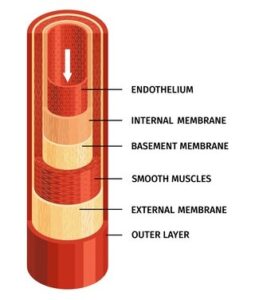
Arteries-
These types of blood muscles are more muscular than veins.
It carries oxygenated blood from the Heart to different body organs.
They are present deep below the muscles.

Veins-
These type of blood vessels carries deoxygenated blood from body parts towards the heart.
Veins are found just below the skin. They are visible to the naked eye.

Capillary–
They are very small tiny blood vessels of the body. Blood Capillaries form a network between arteries & Veins.
They are not visible to the eyes.
Valves
Think of your heart’s valves as gatekeepers.
Four valves regulate blood flow: the tricuspid and bicuspid (mitral) valves control flow between the atria and ventricles.
While the aortic and pulmonary valves manage blood exiting the heart.
Facts about Human Heart
-Your heart beats about 100,000 times daily, propelling around 2,000 gallons of blood.
-The heart’s electrical system ensures synchronized contractions, orchestrating each beat.
-An adult’s heart pumps approximately 70 millilitres of blood per beat.
-The average male heart weighs around 280 to 340 grams. In females, it weighs around 230 to 280 grams.
-An adult’s heart beats about 60 to 100 times per minute, and a newborn baby’s heart beats at a faster pace than an adult which is about 90 to 190 beats per minute.
Conclusion:
In the symphony of life, your heart serves as both conductor and musician, playing the tune that keeps you alive. Every beat, every rhythm is a testament to its ceaseless dedication. Now, as you reflect on the intricacies of the parts of the human heart and their functions, consider this:
How can you show gratitude for your heart’s unwavering commitment to your well-being?
Remember, each moment is an opportunity to honor the remarkable organ that sustains your existence.
